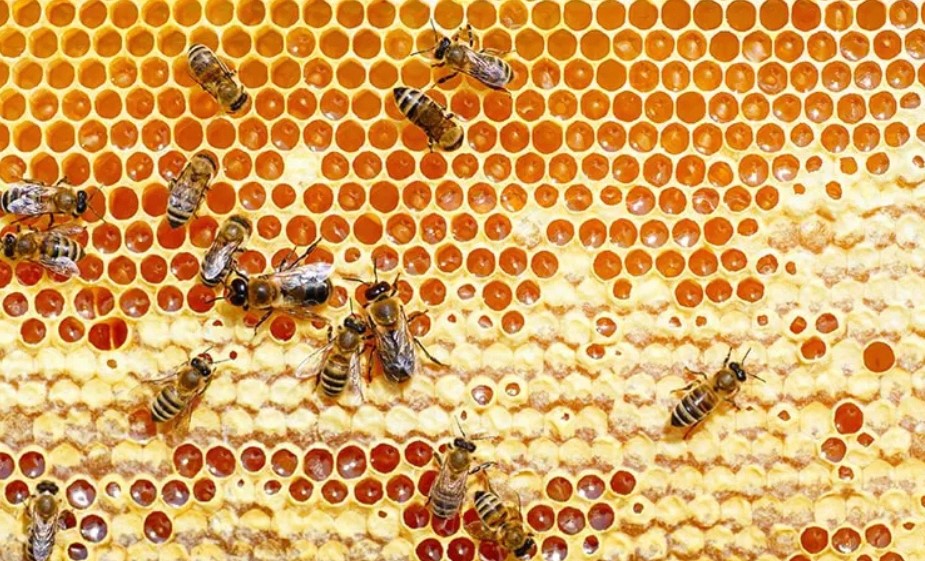Honeycomb is a natural wonder that is created by bees to store honey and raise their young. The intricate hexagonal structure of honeycomb is a marvel of nature, with each cell being perfectly sized and shaped to hold honey and larvae. But how do bees make honeycomb? In this post, we will provide a step-by-step guide on how bees make honeycomb, including four different points.

Gathering Nectar and Pollen
The first step in making honeycomb is for the bees to gather nectar and pollen from flowers. Bees collect nectar by visiting flowers and using their long tongues to extract the sweet liquid. The nectar is stored in a special organ called the honey stomach, where it is mixed with enzymes and then regurgitated into the hive. The bees then use their wings to evaporate the excess moisture from the nectar, creating thick and sweet honey.
Creating Wax
The next step in making honeycomb is for the bees to create wax. Bees secrete wax from their abdominal glands, which they use to build the hexagonal cells of honeycomb. The bees chew the wax to soften it and then shape it into the familiar hexagonal shape. The wax is used to create both the honey storage cells and the cells that will hold larvae.
Building Honeycomb
Once the bees have collected nectar and pollen and created wax, they then use the wax to build honeycomb. The bees start by building a central comb, which acts as the foundation for the rest of the hive. They then build additional combs, adding layer upon layer until the hive is filled with honeycomb. The hexagonal shape of the cells is not only aesthetically pleasing but also serves a functional purpose, as it allows for maximum storage space and efficient use of resources.
Filling Honeycomb with Honey and Larvae
The final step in making honeycomb is for the bees to fill the cells with honey and larvae. The bees use their long tongues to deposit the honey into the cells, storing it for future use. The cells are then capped with wax, sealing the honey inside and protecting it from moisture and contamination. The bees also use the honeycomb to raise their young, depositing eggs into the cells and then feeding the larvae with a mixture of pollen and honey. Once the larvae have matured, they emerge as fully grown bees, ready to continue the cycle of hive building and honey production.
In conclusion, honeycomb is a marvel of nature that is created through the hard work and ingenuity of bees. From gathering nectar and pollen to creating wax and building hexagonal cells, bees use their innate instincts and abilities to create a natural wonder that is both functional and beautiful. The process of making honeycomb is a testament to the complex and interconnected web of life, with each organism playing a vital role in the cycle of pollination, honey production, and hive building. With its nutritional and medicinal properties, honeycomb is not only a delicious and versatile ingredient but also a symbol of the natural world and its infinite wonders.
Conclusion
It is important to note that honeycomb is not only a natural wonder but also a vital component of the ecosystem. Bees play a crucial role in the pollination of plants, which is essential for the growth and reproduction of many crops and wildflowers. Honeycomb is also a nutritious food source for other animals, including birds, insects, and mammals. Without honeycomb and the bees that create it, the delicate balance of the natural world would be disrupted.
In addition to its ecological importance, honeycomb also has many practical uses for humans. Honeycomb is commonly used as a natural sweetener and flavoring agent in food and beverages, as well as a natural remedy for sore throats, coughs, and other ailments. Honeycomb can also be used to create wax products, such as candles, soaps, and cosmetics, due to its natural wax content.
Overall, the process of making honeycomb is a fascinating and intricate one that showcases the remarkable abilities of bees. From gathering nectar and pollen to creating wax and building hexagonal cells, bees use their innate instincts and abilities to create a natural wonder that is both functional and beautiful. Honeycomb is not only a delicious and nutritious food but also a symbol of the interconnectedness of the natural world and the importance of preserving it for future generations.